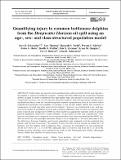Files in this item
Quantifying injury to common bottlenose dolphins from the Deepwater Horizon oil spill using an age-, sex- and class-structured population model
Item metadata
| dc.contributor.author | Schwacke, Lori H. | |
| dc.contributor.author | Thomas, Len | |
| dc.contributor.author | Wells, Randall S. | |
| dc.contributor.author | McFee, Wayne E. | |
| dc.contributor.author | Hohn, Aleta A. | |
| dc.contributor.author | Mullin, Keith D. | |
| dc.contributor.author | Zolman, Eric S. | |
| dc.contributor.author | Quigley, Brian M. | |
| dc.contributor.author | Rowles, Teri K. | |
| dc.contributor.author | Schwacke, John H. | |
| dc.date.accessioned | 2017-04-05T14:30:11Z | |
| dc.date.available | 2017-04-05T14:30:11Z | |
| dc.date.issued | 2017-01-31 | |
| dc.identifier | 249577465 | |
| dc.identifier | 039f584f-511b-483d-b8e6-67b2d6294642 | |
| dc.identifier | 85012279004 | |
| dc.identifier | 000395683200020 | |
| dc.identifier.citation | Schwacke , L H , Thomas , L , Wells , R S , McFee , W E , Hohn , A A , Mullin , K D , Zolman , E S , Quigley , B M , Rowles , T K & Schwacke , J H 2017 , ' Quantifying injury to common bottlenose dolphins from the Deepwater Horizon oil spill using an age-, sex- and class-structured population model ' , Endangered Species Research , vol. 33 , pp. 265-279 . https://doi.org/10.3354/esr00777 | en |
| dc.identifier.issn | 1863-5407 | |
| dc.identifier.other | ORCID: /0000-0002-7436-067X/work/31748221 | |
| dc.identifier.uri | https://hdl.handle.net/10023/10587 | |
| dc.description.abstract | Field studies documented increased mortality, adverse health effects, and reproductive failure in common bottlenose dolphins Tursiops truncatus following the Deepwater Horizon (DWH) oil spill. In order to determine the appropriate type and amount of restoration needed to compensate for losses, the overall extent of injuries to dolphins had to be quantified. Simply counting dead individuals does not consider long-term impacts to populations, such as the loss of future reproductive potential from mortality of females, or the chronic health effects that continue to compromise survival long after acute effects subside. Therefore, we constructed a sex- and agestructured model of population growth and included additional class structure to represent dolphins exposed and unexposed to DWH oil. The model was applied for multiple stocks to predict injured population trajectories using estimates of post-spill survival and reproductive rates. Injured trajectories were compared to baseline trajectories that were expected had the DWH incident not occurred. Two principal measures of injury were computed: (1) lost cetacean years (LCY); the difference between baseline and injured population size, summed over the modeled time period, and (2) time to recovery; the number of years for the stock to recover to within 95% of baseline. For the dolphin stock in Barataria Bay, Louisiana, the estimated LCY was substantial: 30 347 LCY (95% CI: 11 511 to 89 746). Estimated time to recovery was 39 yr (95% CI: 24 to 80). Similar recovery timelines were predicted for stocks in the Mississippi River Delta, Mississippi Sound, Mobile Bay and the Northern Coastal Stock. | |
| dc.format.extent | 15 | |
| dc.format.extent | 1868908 | |
| dc.language.iso | eng | |
| dc.relation.ispartof | Endangered Species Research | en |
| dc.subject | Bayesian model | en |
| dc.subject | Cetacean | en |
| dc.subject | Deepwater Horizon | en |
| dc.subject | Density dependence | en |
| dc.subject | Impact assessment | en |
| dc.subject | Monte Carlo analysis | en |
| dc.subject | Population model | en |
| dc.subject | Survival | en |
| dc.subject | QH301 Biology | en |
| dc.subject | GC Oceanography | en |
| dc.subject | Ecology | en |
| dc.subject | Nature and Landscape Conservation | en |
| dc.subject | NDAS | en |
| dc.subject.lcc | QH301 | en |
| dc.subject.lcc | GC | en |
| dc.title | Quantifying injury to common bottlenose dolphins from the Deepwater Horizon oil spill using an age-, sex- and class-structured population model | en |
| dc.type | Journal article | en |
| dc.contributor.institution | University of St Andrews. Statistics | en |
| dc.contributor.institution | University of St Andrews. School of Mathematics and Statistics | en |
| dc.contributor.institution | University of St Andrews. Marine Alliance for Science & Technology Scotland | en |
| dc.contributor.institution | University of St Andrews. Centre for Research into Ecological & Environmental Modelling | en |
| dc.identifier.doi | 10.3354/esr00777 | |
| dc.description.status | Peer reviewed | en |
This item appears in the following Collection(s)
Items in the St Andrews Research Repository are protected by copyright, with all rights reserved, unless otherwise indicated.

